Horizontal Glass Sandblasting Machine
| Models |
SBM-H-A |
SBM-H-B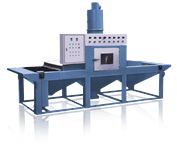 |
SBM-H-C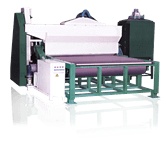 |
SBM-H-D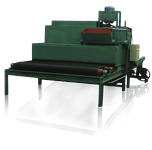 |
| Blasting Process |
Air Blasting |
Air Blasting |
Air Free Rotating Steel Blades |
Air Free Rotating Disc Abrasive with Water |
| Dust Separating Process |
Cyclone |
Bags Filter |
Bags Filter |
N/A |
- Highlights
- Description
- Specifications
Highlights
Automatica High Efficient Multi-Guns Sand Blast Machine
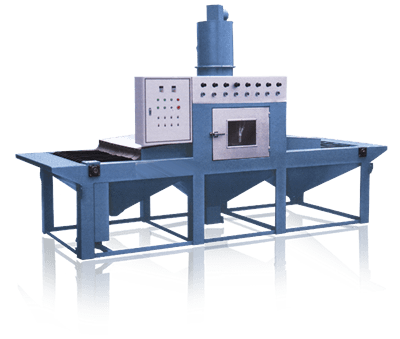
- SBM-H-B glass sandblasting machines apply abrasives on glass surface automatically when glass is traveling horizontally
- Air blast process with blast nozzles powered by compress air
- Automatic traverse movement of blast guns versus glass travel direction
- High efficient bags type filtering & separating system
- Free of dust working environment
- Abrasive proof blast cabin
Description
General
Automatica High Efficient Multi-Guns Sand Blast Machine
- SBM-H-B glass sandblasting machines apply abrasives on glass surface automatically when glass is traveling horizontally
- Air blast process with blast nozzles powered by compress air
- Automatic traverse movement of blast guns versus glass travel direction
- High efficient bags type filtering & separating system
- Free of dust working environment
- Abrasive proof blast cabin
Blast Cabin
It is a well sealed chamber where sand blasting is taken place. Abrasive proof materials and surface treatments enables cabin durable and resistant to abrasives. There are narrow openings at both sides of blast cabin. They allow glass to go in and out. These tiny inlet and outlet openings are specially sealed avoiding abrasives and dust from escaping. There are observation windows allowing real time monitoring.
Automatic Blast Guns & Traverse Moving System
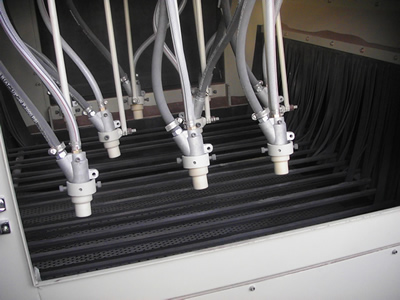
Inside blast cabin, there are several blast nozzles or, sometimes known as spray nozzle, traveling transversely to and fro automatically versus glass traveling direction. Steady oscillating movement of blast guns ensures consistent glass surface blasting finish. Traverse moving speed could be regulated. Position of each blast gun and angle of each blast nozzle are adjustable to obtain optimal glass surface finishes.
Abrasive Blasting System
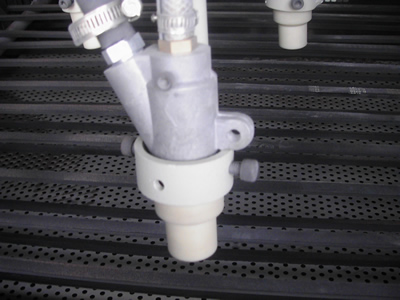
It is a siphon blast system, or sometimes known as suction blast system, using compressed air to create vacuum inside blast guns barrels. The negative pressure pulls abrasive into the blast gun via abrasive proof pipes. Compressed air directs the abrasives through blast nozzles impacting on glass. Abrasives are mixing with compress air during ejection, which fully utilizes compress air. Compress air quantity and abrasive amount are adjustable. Adequate mixing ratio minimizes abrasives and air consumptions.
Abrasive Bags Filter Separating System
It is a standalone structure. Dust separation is achieved by means of bags filtering. This process is a very high efficient way to capture reusable abrasive for recycling from disposal dust. During sand blasting, two types of contaminants are generated.
- a) Glass powder physically eroded from glass surface.
- b) Abrasives which become smaller in size or losing sharp edges after impacting on glass. These shattered abrasives are no more helpful for blasting.
Remaining abrasives are still large in sizes with sharp edges. They are reusable and are separated from dust by bags filtering system. Dusts are smaller and they pass through bags' tiny holes. Reusable abrasives are relatively larger in size and they are too large to pass through bags' tiny holes and finally they are collected in a box at the bottom of the separating system. There is a cylinder which is used to provide rhythmic vibration to shake the bags to make sure bags' tiny holes are not blocked. When abrasive collecting box is full, recycle abrasives are brought to blast cabin manually. Non-usable abrasive and dust are exhausted. They could be disposed in water drainage with plumbing provided by buyer or any other ways fulfilling local laws and regulations.
Motorized Driven Conveying System
It consists of inlet, main and exit conveyors. Main conveyor is inside blast cabinet. Glass is loaded on inlet conveyor. Motorized driven conveyors bring glass into blast cabinet automatically. Glass eventually comes out from exit conveyor. Speed is adjustable.
Control System
Operations are access from this control panel. All electrical and electronics parts and components are carefully selected.
Specifications
| Models |
SBM-H-B-800 |
SBM-H-B-1200 |
SBM-H-B-1600 |
SBM-H-B-2000 |
| Sandblast Width (mm) |
300 ~ 800 |
300 ~ 1200 |
300 ~ 1600 |
300 ~ 2000 |
| Glass Thickness (mm) |
2 ~ 25 |
| Principle |
Air blasting process with blast nozzles powered by compress air |
| Virgin Abrasives Re-Filling |
Manually loaded in blast cabin |
| Dust Separation |
Bags Filter |
| Re-Usable Abrasive Collection |
Automatically collected in box |
| Re-Usable Abrasives Recycling |
Manually brought from box to blast cabin |
| Dust Disposal |
Exhaust to water drainage or water precipitation or any other ways fulfilling local laws & regulations (plumbing & facilities to be provided by buyer) |
| Guns Operation |
Automatic |
| Recommended Abrasive Grit |
#36 ~ #120 |
| Compress Air |
0.5 ~ 0.8 MPa |
| Voltage |
380V / 3 Phases / 50Hz (others on request) |
| Power (kW) |
2.1 |
2.3 |
2.5 |
2.8 |
| Weight (kg) |
800 |
1000 |
1300 |
1600 |
| Outer Dimensions (L x H x W) (mm) |
4000 x 2850 x 1200 |
4600 x 2850 x 1600 |
4800 x 2850 x 2000 |
5000 x 2850 x 2400 |






